Issue #6: Mayo Clinic: Homemade Mayonnaise for Keeps
Potato Salad Days, Still Learning Potato Tricks, Chocolate Cake Recipe Evolves (Sourdough Edition), and More
Welcome to the 6th issue of Kitchen Sense. (If you are a paid subscriber, you’ve had a couple more.) I hope you are enjoying it. If so, please pass it along to friends and family who like to cook. And if you really, really, like it, please consider a paid subscription, which gives you access to the entire archive, another recipe or tip now and then, plus the ability to comment and make special requests.
It’s coming up on July 1, Canada Day, in Canada (duh!), and July 4th, Independence Day, in the US of A. (When I was a kid, July 1 was called Dominion Day, which changed in 1982, when the Canadian constitution was repatriated from the Queen of England.) Though completely different in the stories they commemorate, for me, a dual citizen of both Canada and the USA, both national celebrations conjure images of large family picnics, cravings of grilled meats and barbecue, and of course, potato salad.
I’m not sure why, but for me potato salad is one of those dishes that says summer, outdoor eating, family gatherings. (A scoop of potato salad as a side dish or in a sandwich says Japan to me, but that’s something else, entirely.) I remember a large party at a high-school friend’s cottage on Lake Simcoe in Ontario at which her dad made so much potato salad he had to mix it in a large garbage bag. Ingenious, I thought. #kitchenhack (It goes without saying that if you try this make sure you don’t use a garbage bag treated with rat poison. Or, maybe that depends who’s attending.)
Lately, since we’ve had access to a smoker and a barbecue, I’ve been making potato salad more often than I used to, which was almost never. I make it in very small batches for the two of us, usually to go with barbecued ribs or smoked brisket. One or two potatoes and a hard-cooked egg is all it takes to make a quick and satisfying side dish to eat, indoors or out.
Potato salad got me thinking about mayonnaise.
Hellmann’s Used To Be Best
There was a time, not so long ago, that I always had a jar of Hellmann’s in my fridge and at least one spare in my cupboard, often more. This habit (or is it habitus?) I learned from my mother. She loved Hellmann’s, it was the only mayonnaise to her, and for some reason, whenever it was on sale, she picked up one or two jars for the pantry. (Not unrelatedly, she also always had a dozen or so cans of tuna.) We were never without Hellmann’s (or tuna, for that matter).
When we moved to Canada from the U.S. in the early 1970s, Hellmann’s wasn’t very common, and when you did find it, it was relatively expensive. Canada was Kraft Miracle Whip territory, at least that was my mother’s perception. And although she loved her adopted country, Miracle Whip was unacceptable.
She used Hellmann’s pretty regularly and generously in tuna salad, egg salad, chicken salad, coleslaw, and potato salad, dishes that were in regular rotation in her repertoire. (Thankfully, she did not take to that pareve chocolate cake recipe made with Hellmann’s mayonnaise that made the rounds among Jewish homemakers in the 1980s. She knew where to draw the line.) My mother was a good cook and her mayonnaise-dressed salads were always delicious.
I never thought about not having Hellmann’s in the house until my sister Leslie, in her current keto culinary wisdom, told me she keeps homemade mayonnaise in the fridge for weeks. This was news to me. Even though I always had Hellmann’s in the house, I would occasionally whip up my own mayonnaise by hand for something special, a grand aïoli or oeufs mayonnaise, peut-être. I love the taste of homemade mayo, but the emulsion seemed both ephemeral and maybe even a little dangerous to consider keeping around.
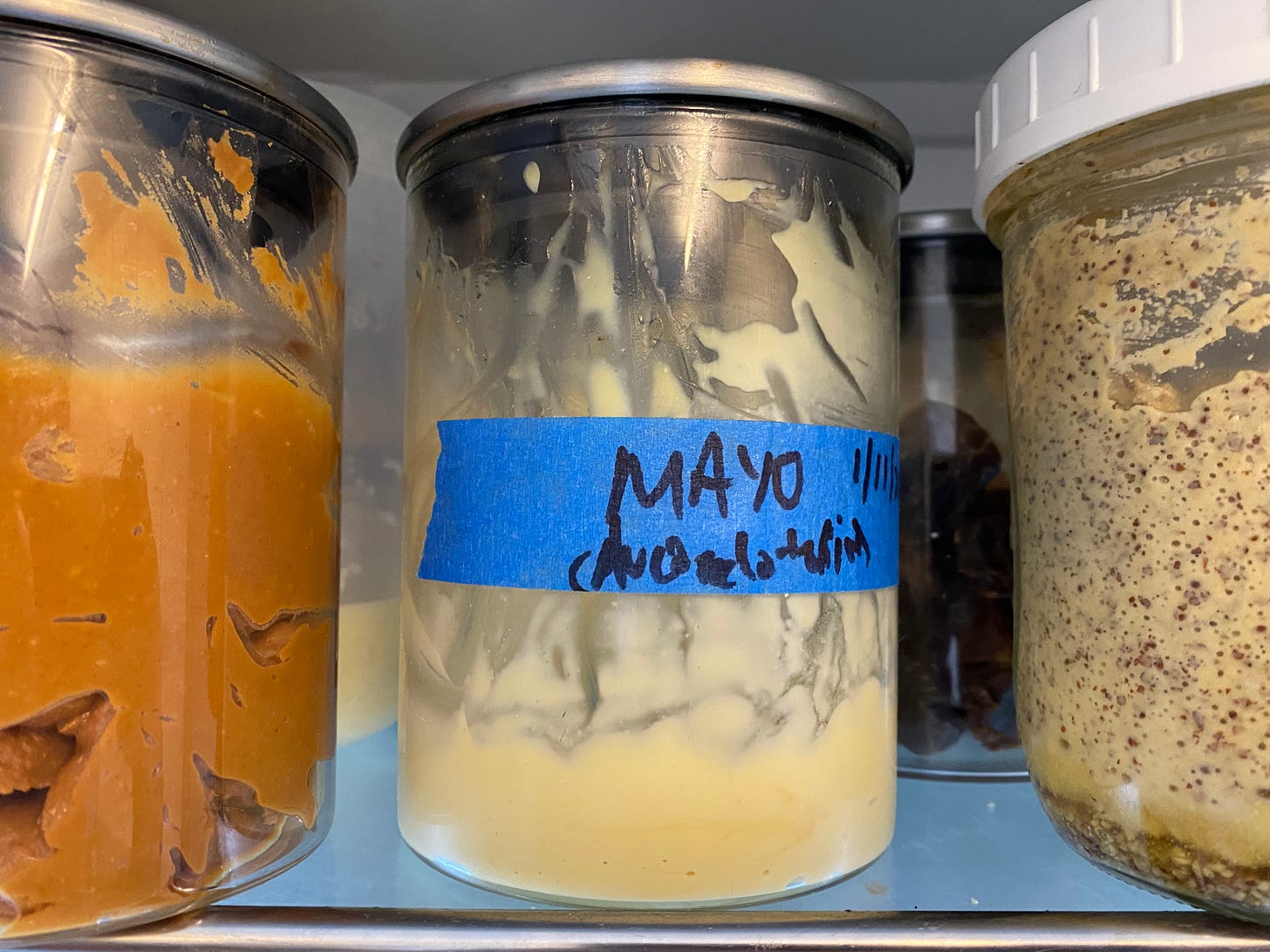
If you’ve been following my Instagram @kitchensense for any time, you know I take pride in making many of my condiments from scratch. There are several reasons. In addition to enjoying the process of making things, generally, I like to tweak the flavors to my liking. I want to know exactly what's in everything I eat and avoid chemicals and preservatives that are difficult to pronounce and even more difficult to digest. I also like to give my money to the people who grow or otherwise produce ingredients rather than those who process them into “higher value” products. These days I make most of our mustard, hot sauce, chili oil, peanut and almond butters, yogurt, pickles, preserved lemons, spice mixes, and now, because I know it keeps, mayonnaise.
Mayo Clinic
It took me a couple of tries to find my “house mayo” formula. I knew that mayonnaise made in a food processor was a much more stable emulsion than mayonnaise made by hand with a whisk, so that was where I started. I began experimenting with different combinations and proportions of ingredients. The thing about a good house mayonnaise is that you don’t want it to be the star. The flavor shouldn’t be so pronounced that it muffles everything else—neither too eggy, nor too olive oily. But you don’t want it to be insipid, either, or else why bother. It also needs enough acid to flavor the salad and to contribute to its safety by lowering the pH.
Speaking of which, I remember learning in a food safety class in hotel school years ago that although we associate the mayonnaise in salads at family picnics with food poisoning, it’s almost always the protein or something else in the salad that is responsible for introducing the pathogen, not the mayonnaise itself. The acidity of mayonnaise inhibits bacterial growth. But poor hygiene, sloppy kitchen skills, or contaminated ingredients can introduce nasty culprits, and the mayonnaise can’t always stop them from reproducing, especially as temperatures rise, other ingredients dilute the acidity, and the salads themselves are poorly handled.

A quick Google search corroborates this recollection, but also reminds me that the mayo myth busters are referring to commercial mayonnaise, e.g. Hellmann’s (see article) Homemade is something else. Still, for my homemade mayo I use only the freshest ingredients, work cleanly, and never let the mayonnaise go unrefrigerated for more than a few minutes, an hour tops. I make it in small enough batches that it only hangs around for a couple weeks or so, and I’ve never had a problem. (Granted my experience, N=1, is statistically insignificant.) If you really don’t want to take any risks, you can use pasteurized eggs for your mayonnaise.
Mayonnaise is a technique, more than a recipe. You mix the egg yolks with acid and flavorings and then slowly beat in oil to make a stable emulsion. I haven’t used a recipe for years, preferring to eyeball the ingredients I dump into the food processor and letting the machine whir wile I drizzle in the oil. I’ve tried whole-egg mayonnaise, using both the white and the yolk to avoid any waste, but I prefer the flavor and texture of yolks-only mayo. (I save the whites to scramble for breakfast.) As with almost anything I cook, I will use up things I have lying around in my mayonnaise, such as the dregs of a vinaigrette, a spoonful of sour cream, some Hellmann’s. Nevertheless, I’ve measured what I do to provide you recipe as a framework, below.
As for oil, a combination of extra-virgin olive oil and a more neutral oil is my flavor preference. You can do it with all of one or the other, but I like the flavor of the combination, not too strong or too weak. For a long time I was using avocado oil to complement the olive, but a recent bulk purchase of avocado oil had an off taste that I couldn’t get out of my head. I don’t know if it was rancid or what, but it’s all I could taste if I used that mayo for anything. I threw it out. I still haven’t discarded the remaining 3 liters of the oil I have left, but I’m afraid to use it. Instead, for the last couple of batches I used grapeseed oil, and the result is light and delicious.
The acidity in my mayo comes from a combination of lemon juice and white vinegar, the latter added toward the end, once the emulsion has thickened. I wait to add it because some lemons are more acidic than others so I like to be able to adjust the taste once I have a sense of the overall flavor of a particular batch. You could also use white wine or apple cider vinegar, but the sharpness of white vinegar gives me a taste I think is closer to the Hellmann’s I’m replacing with this house blend.
A relatively recent innovation that I’m quite happy with is adding a spoonful of white miso to the base, the milder Kyoto-style saikyo white miso if I have it. Similar to the Dijon, the miso serves as a kind of booster, adding a layer of umami to the finished mayo and helping to further stabilize the emulsion.
RECIPE: Homemade Mayo
Makes about 1 cup
2 egg yolks
1 heaping teaspoon Dijon mustard
1 heaping teaspoon white miso, saikyo miso if you have it
Juice of 1 1/2 lemons
Pinch salt
About ½ cup extra-virgin olive oil
About ½ cup mild oil, such as grapeseed or avocado
1 tablespoon white vinegar
Water
In the bowl of a food processor fitted with the metal chopping blade, combine the egg yolks, mustard, miso, lemon juice, and salt. Process for 30 seconds or so until well blended. With the machine running, slowly drizzle the oils through the feed tube to form a stiff emulsion. From time to time, stop the flow of oil to allow the emulsification to catch up. About halfway through, add the vinegar and then continue adding the oil. The mayonnaise should be stiff and creamy, holding its shape on a spoon, like beaten egg whites. If it looks too stiff, or the taste is too strong, you can adjust the flavor and texture with a spoonful of water. Counterintuitively, if it is too thin, drizzle in more oil. You can also add more salt or vinegar, to taste.
Transfer the finished mayonnaise to a clean container and refrigerate for up to a maximum of 3 or 4 weeks, being sure to always use a clean utensil to take out what you need. I don't like to waste any of the fresh mayo left in the processor bowl, so that's where some fresh bread, a hard-boiled egg, or just your fingers come in handy to clean it out and enjoy it.
You’ve Made Mayo, Now What?
I transfer the mayonnaise to a wide-mouth jar with a tight-fitting lid, label it with the date, and place it in the fridge immediately. In addition to the typical mayo-based salads, I add a dollop of mayo wherever I can. A spoonful turns a simple vinaigrette into a creamy dressing. I like to cut mayo with Greek yogurt or sour cream for certain dressings. It’s delicious in this ranch dressing in Issue #2 of Emily Nunn’s Department of Salad newsletter. For a while I was only removing half of the mayo from the processor bowl to store plain and then beating flavorings into the other half, such as harissa, pesto, or zhug, to make bold condiments to serve with meat or fish, or to perk up sandwiches. Use your imagination. A dab of spicy mayo on a half a hard-boiled egg makes a speedy, elegant hors d’oeuvre. Good homemade mayonnaise is a star player in open-faced Danish smørrebrød. It’s a great dip for Hong-Kong-style fried seafood, and nothing is better for as a dip for Belgian-style fries.
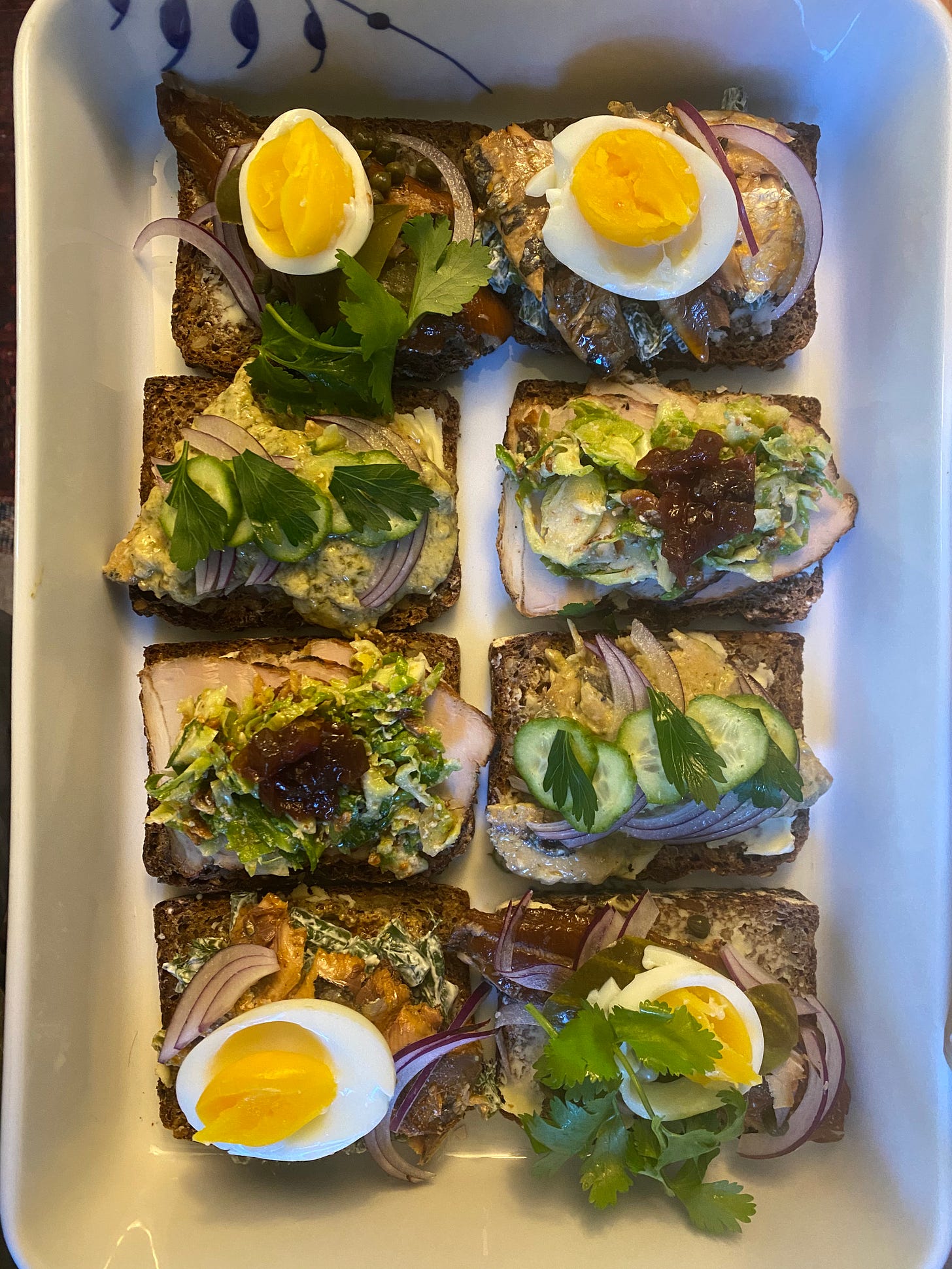
To get yourself ready for July 1st or 4th, let me share my basic potato salad recipe, and a few ideas for mix-ins. But first…
My Potato Salad World Recently Changed
A note about cooking potatoes for potato salad. My mother, and therefore I, always boiled the potatoes for potato salad whole in their jackets, that is, unpeeled. She put the whole potatoes and eggs in a pan, covered them with cold water, added a generous pinch of salt, and set them over high heat. Once boiling, she reduced the heat to a simmer. If she remembered to remove the eggs after 15 minutes or so to prevent overcooking them—I’d say 50% of the time—at that point she’d started poking the potatoes with the tip of a paring knife to try to determine when they were cooked enough, but not all the way. The whole operation was tricky as potatoes of different sizes, densities, and starchiness cook at different times. The key to a potato salad is not to overcook the potatoes so that they are mush; they still need to have a bite to them. Otherwise, you end up making cold mashed potatoes. When a potato seemed done, my mother removed it from the pan. Once they were all cooked and drained, the peeling began, which could be a little tricky, too, if you were in a hurry. You learn quickly where the term “hot potato” comes from. Peeling can be messy, too. Ideally, you should chill the potatoes first, then peel and cut them into cubes.
But just a few months ago, during a pandemic pod trip to Fire Island, our friend, chef Laurent Gras, was prepping potatoes for a salad, and he peeled and diced the potatoes before boiling them in a shallow pan. While this may seem like a totally obvious thing to do, it was a revelation to me. I repeat, he peeled the potatoes raw, cut them into equal sized cubes, cooked them in a shallow pan of salted boiling water, stopped the cooking while they were still al dente, which was at the same time for all of them, drained and rinsed them with cold water, et voilà, in 20 minutes or so they were ready to be tossed in a salad.
So now I make my potatoes this way, it’s faster and more accurate (sorry, mom, RIP). Boil the eggs on the side.
RECIPE: Mitchell’s Potato Salad
4 to 6 (1 ½ to 2 1bs) smallish waxy potatoes, such as red bliss, Yukon Gold, or German Butterballs
Salt
2 stalks celery, diced
1 pickle, dill, kosher dill, or sweet, finely diced, plus a tablespoon or more of the pickle brine, or a handful of sliced bread-and-butter pickles, chopped
2 hard-cooked eggs, chopped
½ to ¾ cup homemade mayo, or a combination of mayo, Greek yogurt, and/or sour cream
¼ to ½ medium red onion, according to your onion preference, finely diced
2 scallions, white and green parts, chopped
1 tablespoon capers, rinsed and minced
Dash of Tabasco or other hot pepper sauce
Freshly ground black pepper
Peel the potatoes and cut into 1-inch dice. Different shapes are favorable to me for a homemade feel, as long as the sizes are about the same. Bring a shallow pan of water, just enough to cover the potatoes, to a boil with a generous pinch of salt. Add the potatoes and cook until they are just tender when poked with the tip of a paring knife. They should retain their shape and not fall apart. Remove from the heat and drain. (I save the starchy cooking liquid to use for making bread.) Rinse the potatoes briefly under cold water to stop the cooking and cool. Drain again.
Meanwhile, in a large bowl, combine the celery, chopped pickle, pickle juice, chopped egg homemade mayonnaise, red onion, scallions, capers, and Tabasco, along with the potatoes and a few grins of black pepper. Adjust the seasoning with additional salt and pepper, and pickle juice, if necessary. You can use more mayo, if you like, as well. Chill completely before serving.
Mix-Ins I’ve Added to Potato Salads Past
Here’s a selection of things I have added to my potato salads on occasion. Feel free to draw items from this list to add to the above recipe, alone or in combination. I’d avoid adding all of them to any one salad. Heed Coco Chanel’s advice and remove one thing before going out.
¾ cup fresh or frozen peas, blanched
2 or 3 strips crisp bacon, chopped
2 or more tablespoons chopped gribenes (crisp chicken skin)
1 tablespoon pickled mustard seeds
1 heaping tablespoon sweet relish
2 tablespoons mango chutney
2 tablespoons or more chopped fresh dill
2 tablespoons or more crispy fried onions or Thai fried shallots and/or garlic
1 tablespoon minced preserved lemon peel
2 teaspoons toasted curry powder
Chopped pickled ramps
A New Development for the Chocolate Cake Recipe in Issue 3
I’m not sure why I didn’t think of this sooner, but I just this weekend realized that @bravetart‘s whole-grain chocolate cake recipe shared with you in Issue 3 is a perfect receptacle for sourdough starter discard. I only use whole wheat or whole rye at 100% hydration for my starter, so the discard substitution is easy. I simply replaced some of the flour and the coffee with the starter. The result met Nate’s approval, the slight acidity of the starter adding to the complex flavor of the cake (think buttermilk or sour cream). Here’s the new formula for a 9” round. The method is the same, just dd the sourdough starter where you add the flour.
RECIPE EVOLUTION: @Bravetart’s Whole-Grain Chocolate Cake, Sourdough Edition
For 9” round
170 g light or dark brown sugar (about 3/4 cup)
64 g Dutch-process cocoa powder (3/4 cup) (I use Valrhona)
½ teaspoon fine sea salt
1 teaspoon baking soda
190 g extra-virgin olive oil (1 cup)
95 g strong, brewed coffee (scant 1/2 cup)
3 large eggs
2 teaspoons vanilla extract or paste
150 g whole-grain, 100%-hydration sourdough starter discard (about 2/3 cup)
35 g whole wheat or rye flour (scant 1/4 cup)
Powdered sugar and fruit for garnish.
See Issue 3 for the method.



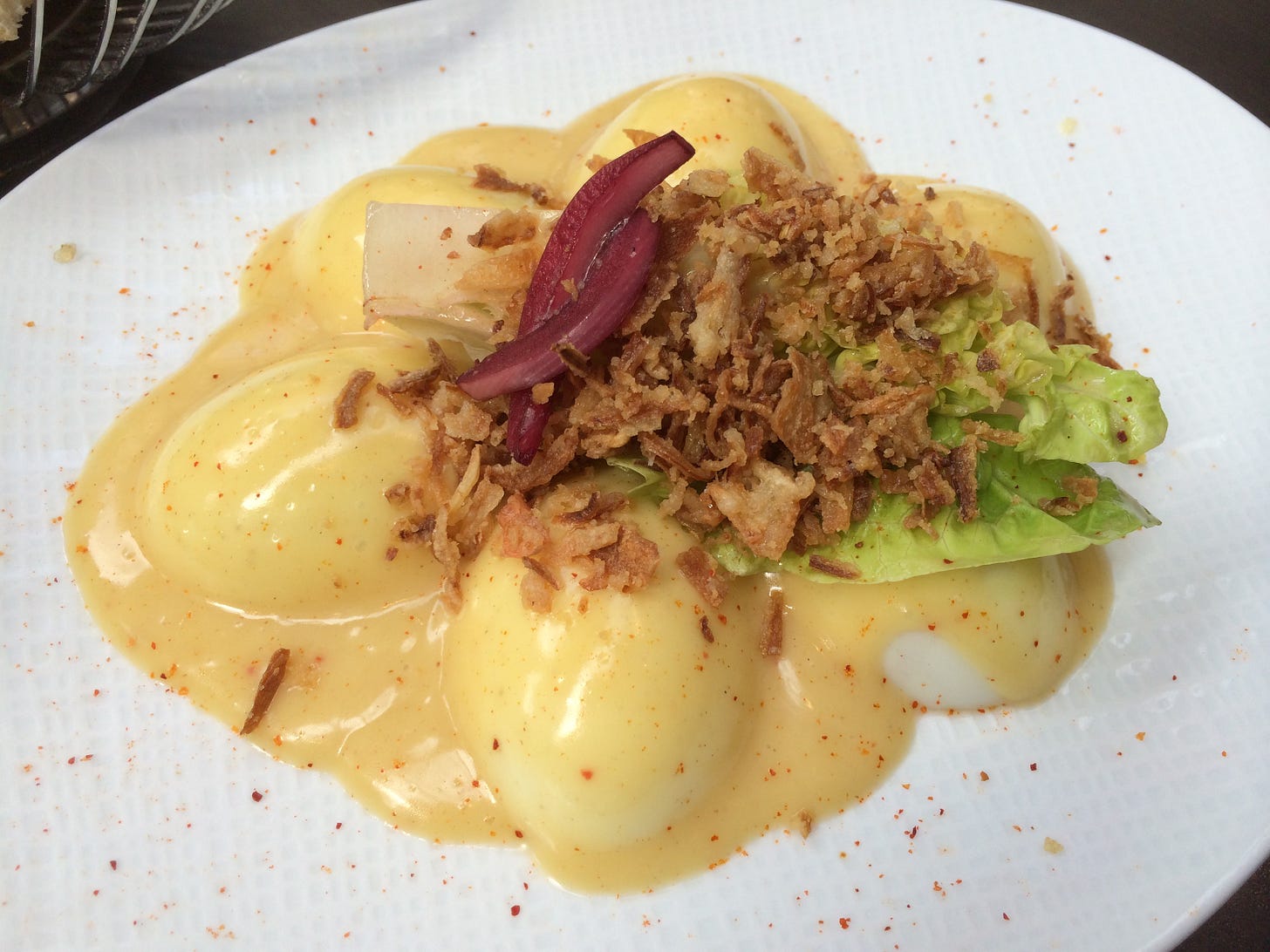
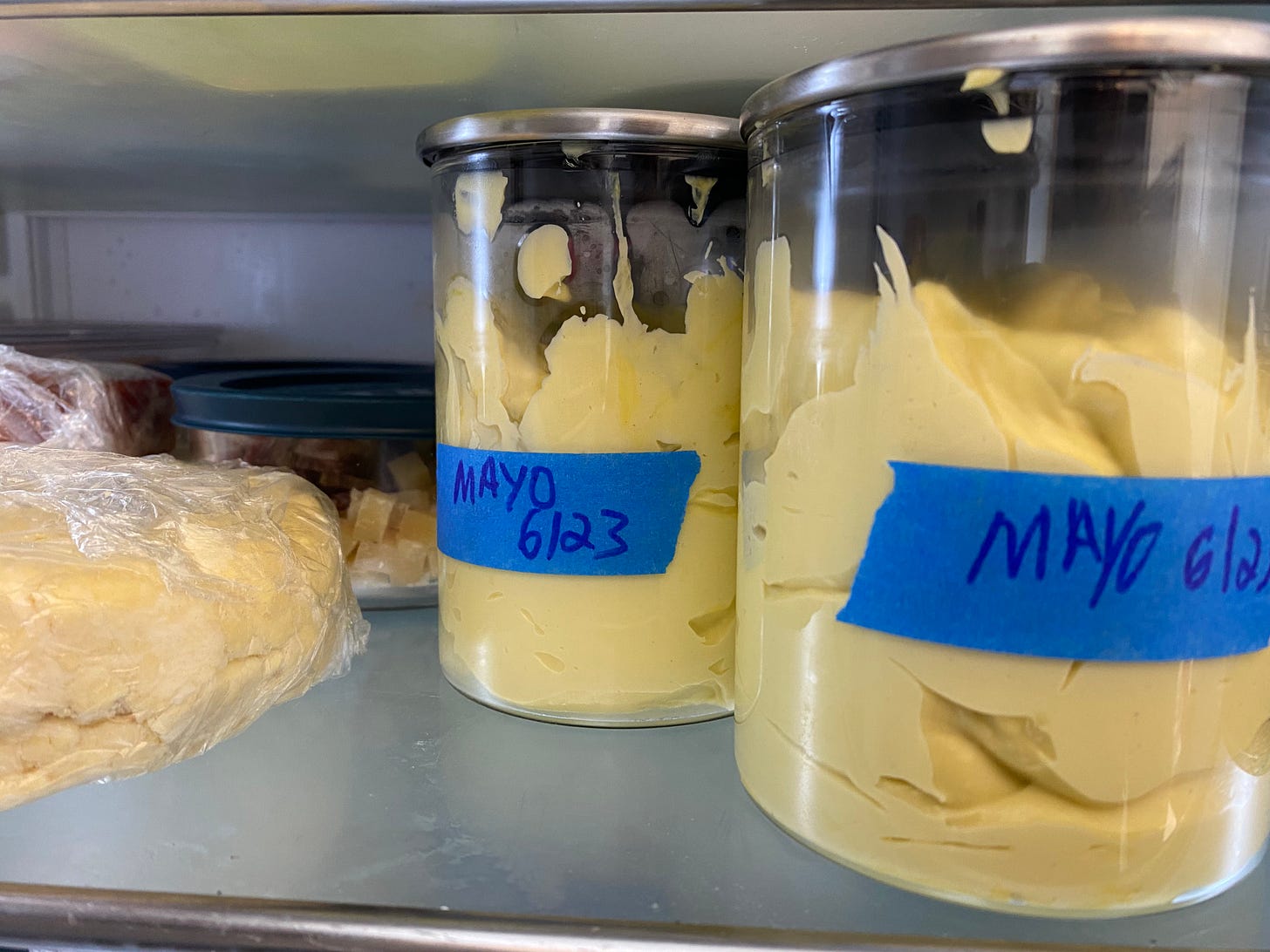
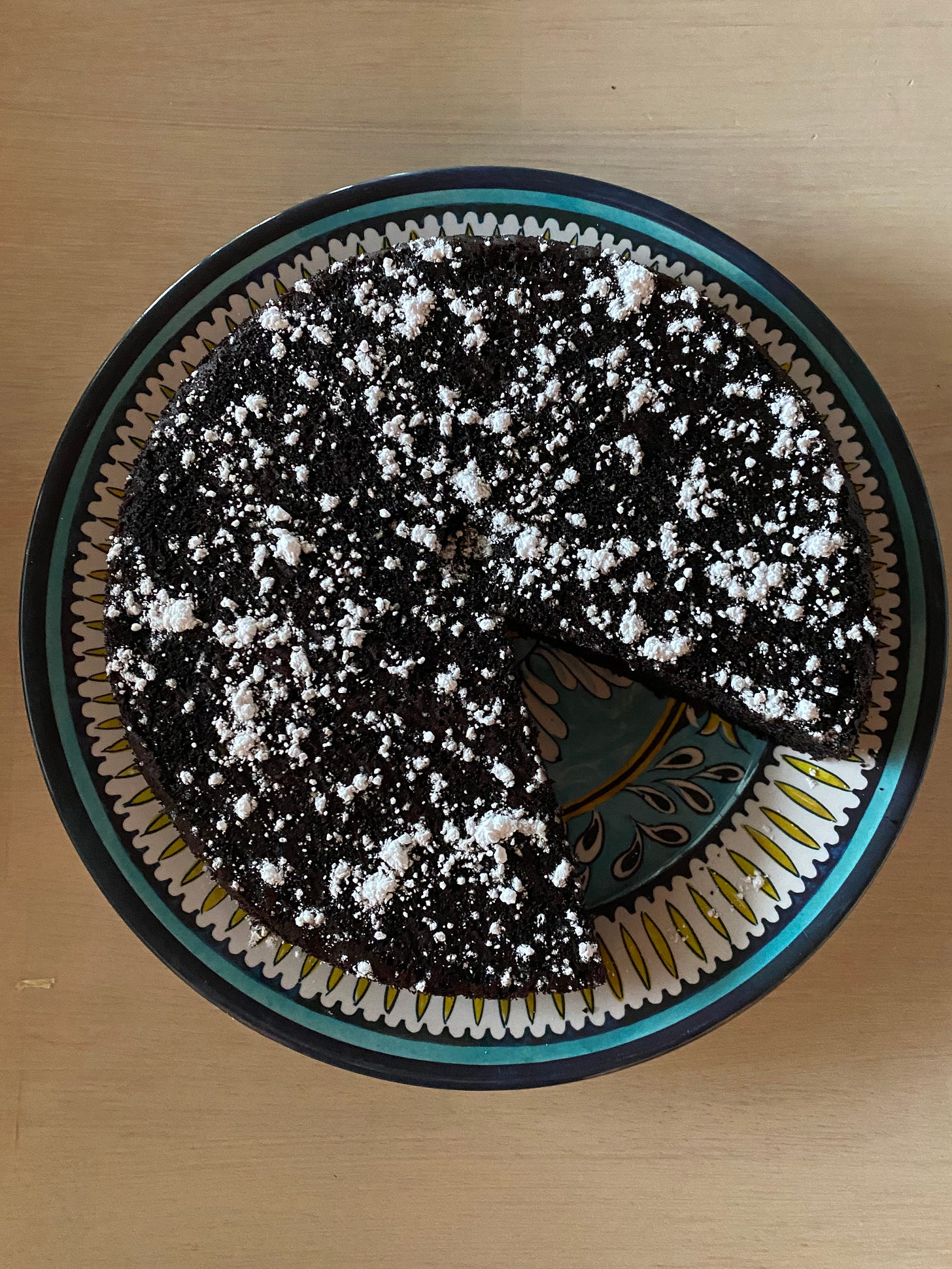
I have had great success using an immersion blender. everything , oil included, goes onto a beaker, turn the stick on and don’t move it until the emulsion begins and then slowly move it up and down to incorporate the oil.